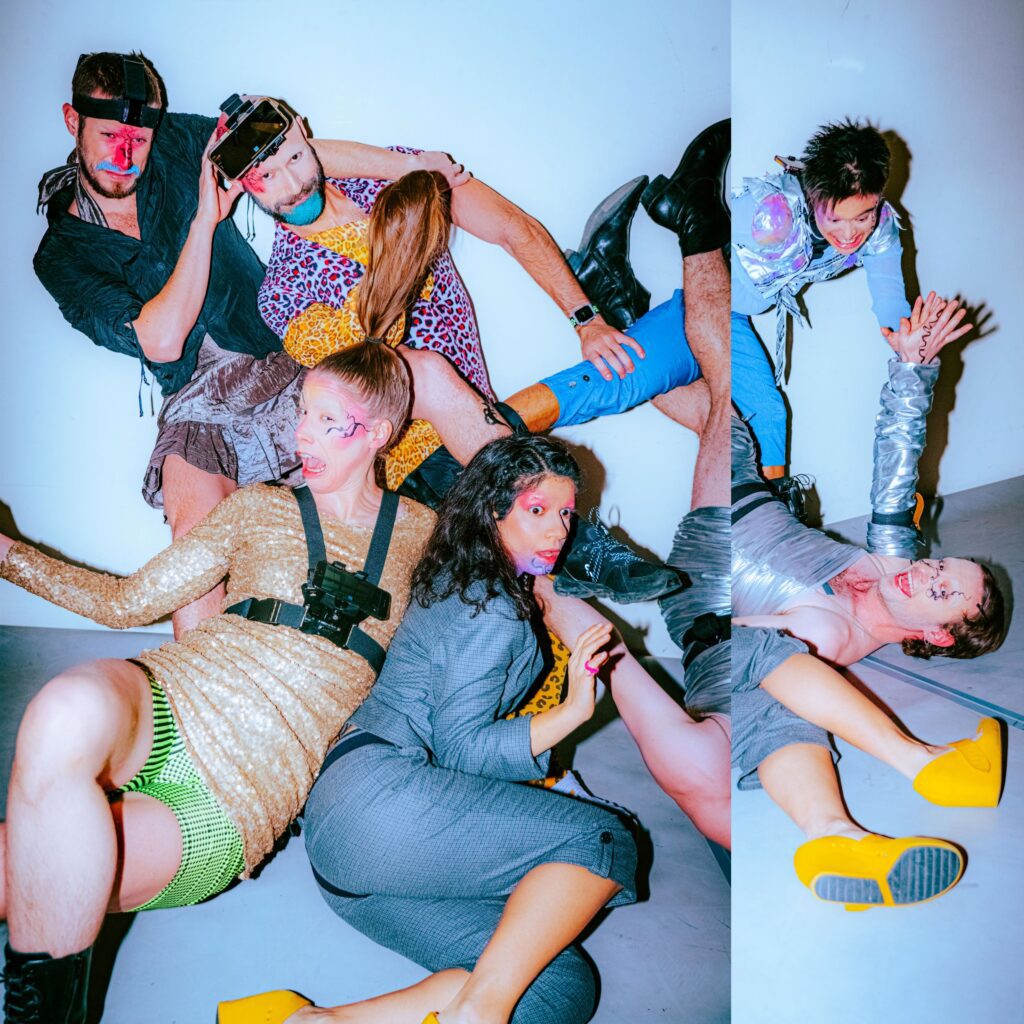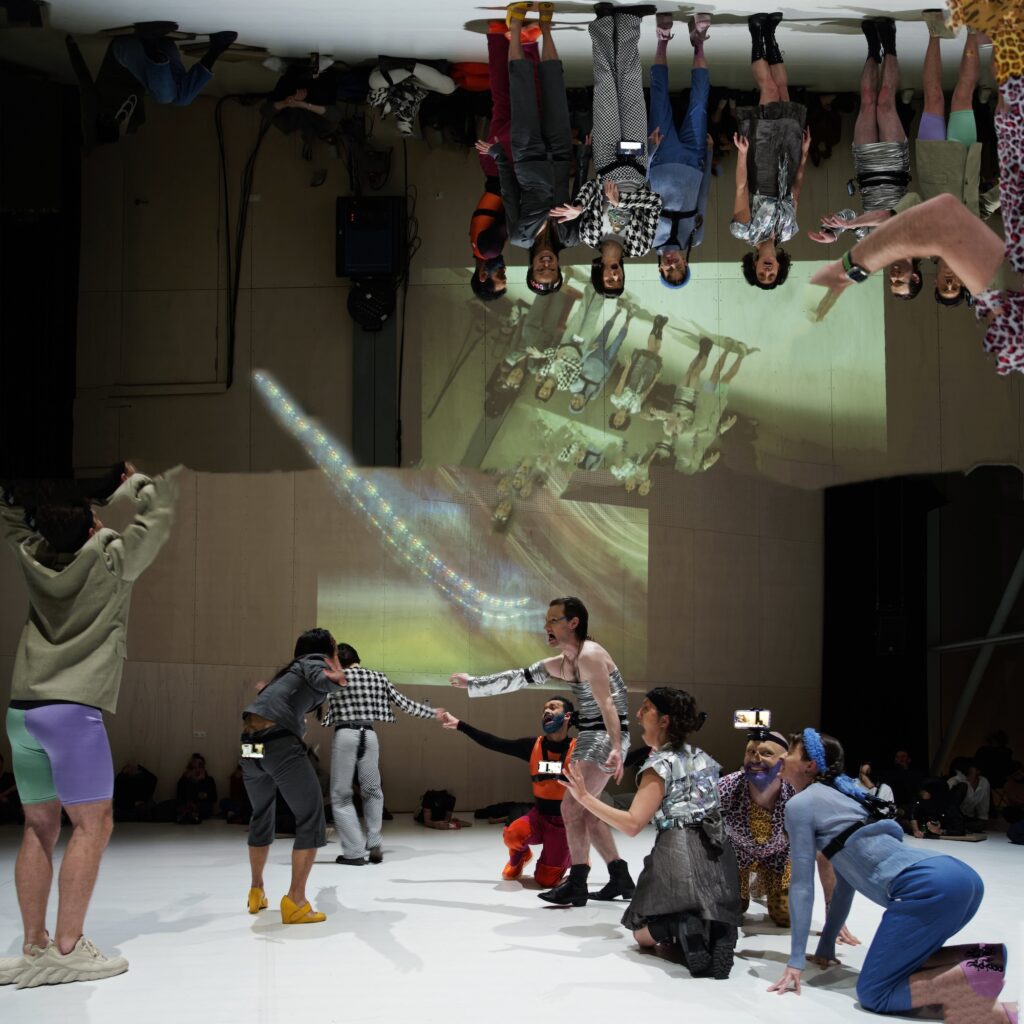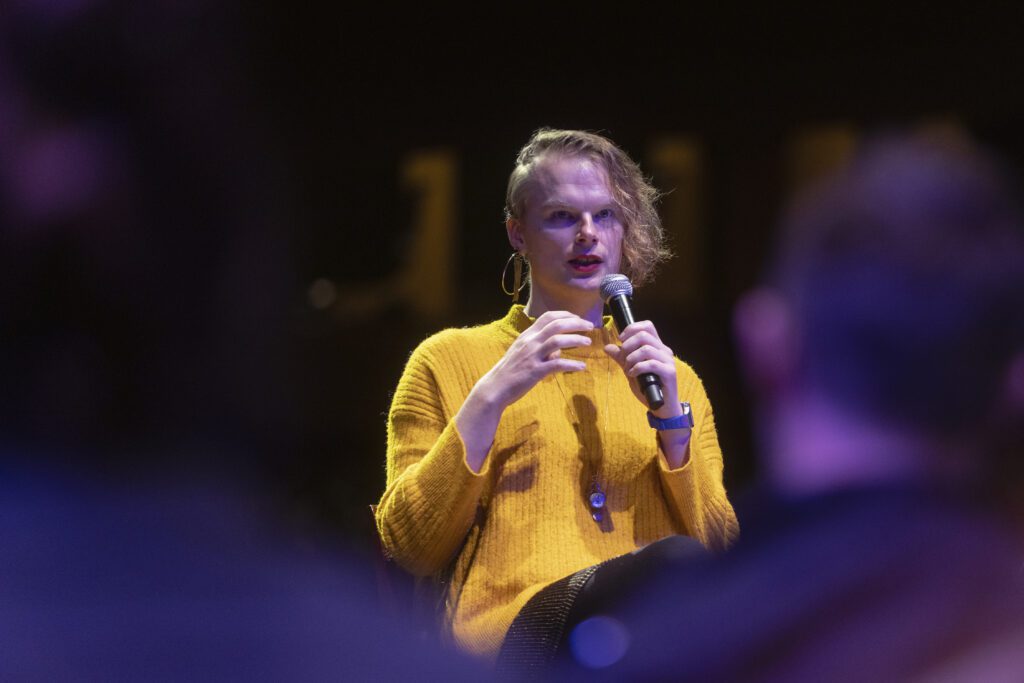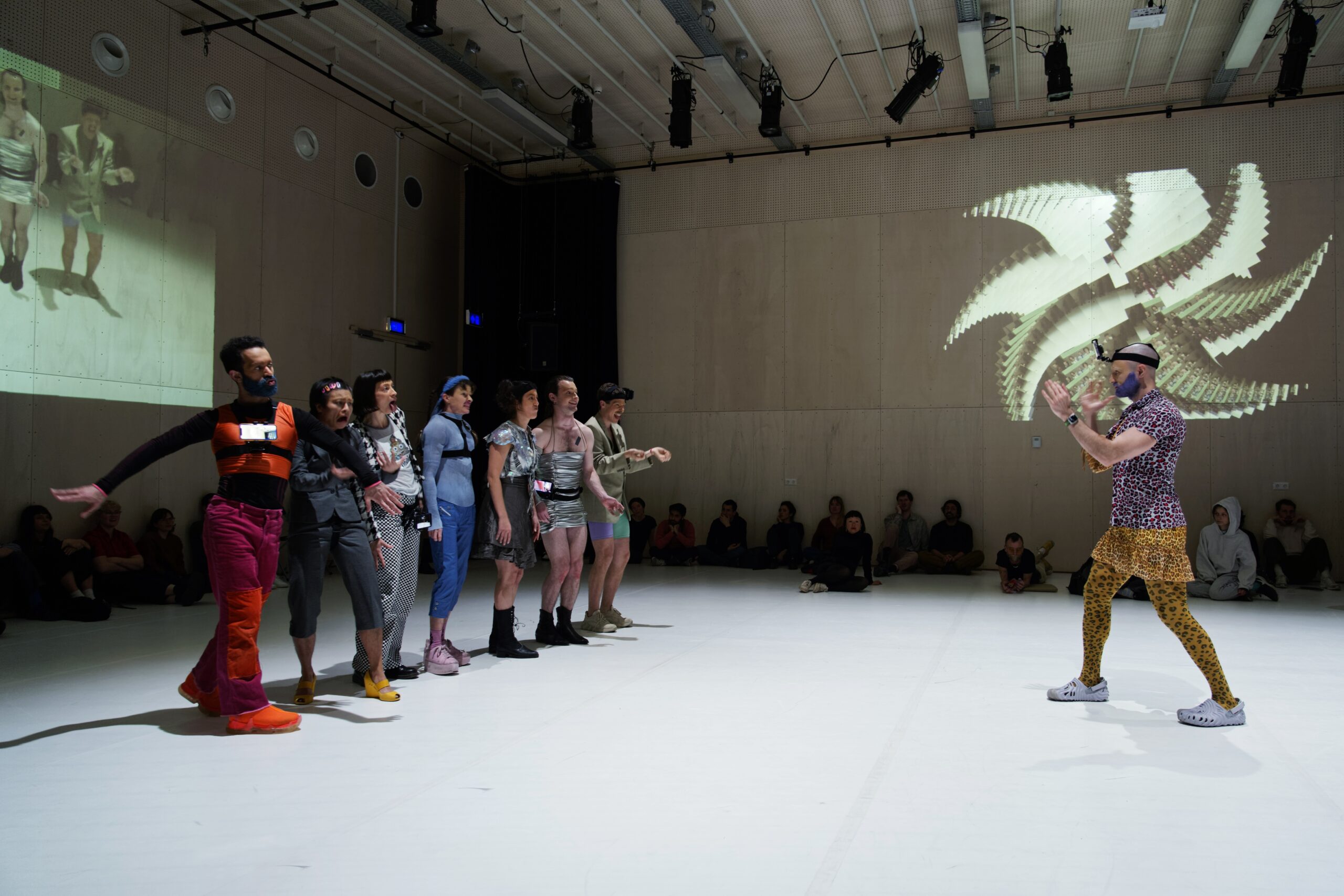3M0T1NG{/n3tw0rk1ng}, DAS Choreography 2023 Credit Thomas Lenden
I was recently part of a panel titled “AI, Performing Arts & Identity – Exploring Gender, Ethics, and Representation in Digital Art” during the Festival Dias da Dança. It sparked in me a curiosity about how queer artistic uses of and representation in digital spaces affect audiences and influence what is possible for queer bodies, both physically and digitally.
This led me to consider my friend Zander Porter‘s performance research 3M0T1NG{/n3tw0rk1ng} (“emoting/networking”). In this writing, I will explore this work through Kara Keeling’s Queer OS. How do queer artists think about the effective and affective registers of digital representations of queer bodies (on queer bodies)? How do these digital avatars affect different understandings of the self? What might this suggest about how queer artists might respond to and with AI in their art? While Zander’s dance does not specifically pertain to AI, nor consciously utilize AI (although it is undoubtable that the choreographer is aware of AI’s use in smartphone videography), it nevertheless makes sense to utilize this work to think into some of the questions posed by AI in dance. In “Transindividual Equations/Matrices” (2023), Zander speaks of xyr work as a:
…Choreographic therapeutics for moving-sensing-feeling-thinking-communicating bodies in a potentiated post-neoliberal matrix. This conceptually kindled matrix queers and re-illustrates “networking,” which inherently invokes the abundance of worlds colonized and controlled by big-tech and social media corporations. Generated is a set of direction-possibilities both written and danced/visualized for a post-internet-bodied world consumed by individualizations and self-captures – desiring instead towards new “ceremonies,” “rituals,” or telepathic forms of care/presence/therapy for being-together technogenetically. The concurrent/ongoing choreographic research/performance 3M0T1NG{/n3tw0rk1ng} peeks into this togetherness as a xeno-spacetime containing relating, cyber-worlding (meta-)selves.
Thus we can see, Zander is considering the connection and impacts of xyr work on the digital world, queer representations, and bodies.

Turning then to our conceptual foil for this writing, “Queer OS,” writes Keeling (2014), “seeks to make queer into the logic of ‘an operating system of a larger order (McPherson, 2011 [citation added])’ that unsettles the common senses that secure those presently hegemonic social relations that can be characterized by domination, exploitation, oppression, and other violences.” Queer OS has three main strategies: problematizing logics of sense making, making visible that which is obscured, and disrupting relationships enabled through “lenticular logics.”
By “lenticular logics” Keeling refers to Tara McPherson’s work exploring the connection between the development of the early computer operating system UNIX and racial civil rights movements, which both were happening in the US in the 1960s. She describes the way these two phenomena are rarely understood in relationship with each other despite their close temporal, spatial, and social proximity. Likening this to the 3-D postcards common in the US during this period that showed two different images but never at the same time, McPherson describes this as “lenticular logics.” McPherson points out how the development of UNIX followed this very logic in the developers’ insistence on modular code of limited complexity with clean, compatible, and interchangeable interfaces which operated “transparently” (2011).
What Keeling thus is calling for in her Queer OS is a rejection and interruption of the exchanges (relationships), whether social or technological, built on logics which separate and simplify with pre-packaged forms of connection and commitments to taxonomical transparency, where each part is viewable without any mechanism to see the whole.
With this basic, and obviously simplified, understanding of Keeling’s Queer OS, I would like to now turn to 3M0T1NG{/n3tw0rk1ng} to explore the way Zander utilizes performance and digital representation problematize “the (matrix of) self” (Porter, 2023). The performance, which I saw in September 2022 at DAS Graduate School in Amsterdam, utilizes different constellations of two, four, six, or eight performers in a scored choreography of memetic overwhelm. The performers enter in costumes often adjacent to, yet referential of, stereotypical outfits, whether the businesswoman in a power suit, the fag in leopard print, the club girl in a silver mini-skirt, etc. Strapped to each performer is one or more phones with cameras and screens pointing outward from various parts of the body. Projected on several walls of the theater are videos spliced together from the different camera-phones, which are shot in real-time as the dancers move around the space.
Taking Keeling’s notion of unsettling common sense, we can see this in several moments. First, the cameras on the bodies were often placed in such a way as to disrupt a typical understanding of how a camera should be used. Such locations included the performers’ crotch, back, hip, forehead, etc., all of which moved against the idea that a camera goes in front of the face so the videographer can see what they are filming while disrupting the notion that the ocular should be king of the visual. Why can’t someone’s sacrum control the visual representation offered to the audience? The performance takes this further to disrupt the assumed dominance of sight as a main driver of identity. “The performative inquiry,” writes Zander (2023), “and practices proposed by this research seek to interpolate and complicate vision as an ocularcentric crux for an arrival at rethinking/rewriting/re-feeling/(re)moving the (matrix of) self.” Not only is this achieved through building a kind of distrust in the audience for their sense-making of the performer’s facial expressions (discussed more below) but also through a disregard for stable or precise camera work, which in some can induce motion sickness and in others pose questions about how important any particular video projection is.
This interruption of the assumed order and visibility of the videographic act is also an example of making the invisible visible by revealing common assumptions about the photographic object (in this case a video). Beyond this, what is filmed has a revelatory effect. The audience is confronted with our active participation in the performative act when we are captured by the cameras and then projected larger than life onto the walls of the theater. Similarly, the environment is revealed through the odd angles of the videos due to the placement of the cameras on the performers’ bodies. Seeing the theater space, one I had seen countless times before, from the angle of a performer’s crotch as they slowly did a backbend offered me the chance to consider anew the space and my relationship to, and between, its various parts. This was not the only kind of relationship that was disrupted. The layered nature of 3M0T1NG{/n3tw0rk1ng} with its live performance, video projections, audience reactions, and sound design all mashed together, disrupted many relationships based on lenticular logics. For example, we can think of the example above about common assumptions about how video work is captured and displayed and the way often these acts are separated from each other. We might also see this in the movement itself. Starting with simulations of eye contact and the dancing face (off-)mirrored are used to disconnect from “true” feelings and to create new languages and ways of relating to and in post-internet bodies. “Through psychic, physical, and emotive dimensions of mirroring/emoting practices,” writes Zander (2023):
Multiplicity and division are experienced via dissociation (from known/familiar reactions and expressions), disembodiment (via “relocating” possessed eyes and kinesthesia via/through/between eyes of other flesh and devices), and psychosomatic skepticism (through questioning, resisting, and remixing intuitive modes of seeing/sensing self/other, exposing/expressing an emotion or face, or gesturing/adjusting segments of the moving body, particularly the hands).
The disturbing mimetic movements of the performers elicit in the audience a distrust in what they are feeling/thinking, disassociating spectators from their body, culture, history, from everything that supports them in reading bodies. Smiles or power suits are divorced from their typical range of meanings.
3M0T1NG{/n3tw0rk1ng} also suggests an interesting idea about transparency as it might be understood through Queer OS. While the whole of the work was hyper visible, with bright lighting and large projections, the individual elements, the constructive components, were quite obscure. Much like many AI models, the operating logics were obscure to the audience. As the performance progresses, the videos begin to be warped through some video program making the images spin and swirl, fading in and out of the foreground of the projection. Similarly, while we can see the performers’ faces, we do not know what drives them to make the expressions they do. All we are left with are the effects on each other and us the audience, effects which are often strange to our expectations of what such expressions should elicit. Zander points out a lenticular logic relationship between transparency in the form of data and labor and individuality. Zander writes:
It is important to note that transparency (e.g., unprotected data and free-online labor through internet participation and clicks) and individualization (e.g., capitalist-colonial erasure of the significance of collectivities/socialities/welfare) paradigms influence arguably delusional singularizations and self-isolations of a (psychosomatic) matrix/reality. Phased from this difficulty are questions about live(d), perceivable, or collectively-experienced body-borders, and how such pillars of isolated selfhood can be problematized in performative (corporeal and intellectual) inquiry. This is also to articulate that an emergent, apocalyptically neoliberal body-normativity fails to preclude questions around the interconnected and interrelational functions of identification, personhood, and selfhood. Experienced by the bodies projected from the self as both flesh and pixel, post-internet transindividuality presupposes (some of) these functions.

In this we see the connection of unfettered access to our data and labor and big-tech’s increasing individualization of the self. Artists working with AI will need to consider many of these same issues. How do they choose to relate to most AI systems’ use of unprotected (and uncompensated) data as well as free and exploitative labor (for example, Kenyan workers paid €2 per hour by OpenAI) (Perrigo, 2023)? In what ways does their work and digital representations acknowledge the interdependent, co-constituted, interconnected selves we all are?
3M0T1NG{/n3tw0rk1ng} opens up many questions and offers glimpses at strategies artists should consider in approaching AI. Considering the logics, relationships, and common senses which fostered and are fostered by the cyber spaces and other technological resources artists use is an important aspect of a queer engagement with the digital. Kara Keeling’s Queer OS offers one counter logic to “those presently hegemonic social relations that can be characterized by domination, exploitation, oppression, and other violences” (2014).
By Elioa Steffen, Associate Researcher ATD Lectorate
Works Cited
Make ChatGPT Less Toxic,” Time, January 18, 2023, viewed 18 May 2025.
https://time.com/6247678/openai-chatgpt-kenya-workers/.
Porter, Zander. 2023. “Transindividual Equations/Matrices,” Performance Philosophy 8(1).
Porter, Zander. 2023. 3M0T1NG{/n3tw0rk1ng}. Modular performances with Isis Andreatta, Juan Pablo Cámara, Ahmed El Gendy, Forough Fami, Lucas Lagomarsino, Alina Ruiz Folini, Raoni Muzho Saleh, Charlie Laban Trier, Simone Gisela Weber, & Jakob Wittkowsky, music by Li Yilei, costume by Dynno Dada, makeup by Grizolda & Hassandra, technical by Bram Snijders, outside-eyes with Setareh Fatehi & Elisa Zuppini, mentorship via Erin Manning, DAS Theatre, Amsterdam.
Porter, Zander. n.d. Zander Porter Vimeo Channel. Vimeo. Viewed May 20, 2025. https://vimeo.com/zandeh.
Steffen, Elioa. 2025. “Uncommon Forgings, Reflections on Zander Porter’s 3M0T1NG{/n3tw0rk1ng}.” Premiere Project Blog. 27 May 2025. https://premiere-project.eu/Uncommon-Forgings-Reflections-on-Zander-Porter’s-3M0T1NG{/n3tw0rk1ng}

Elioa Steffen (She/They, USA/NL) is an artist working in the fields of performance, visual art, and curation. Her work focuses on the intersection of communal narratives, cultural norms, and systemic violence. At the heart of Eloai’s practice is the pursuit of a queer belonging, an effort to entangle with others and the world beyond the normative structures we have inherited. Currently, she is working in several collaborative constellations exploring both trans-feminine voice in religious ecstasy, the pedagogical possibilities of madness, and queer artistic feedback. She is an alumna of DAS Theatre.
Debate recording:
The event was hosted by Coliseu Porto Ageas in collaboration with DDD Festival – Dias da Dança.
Panel participants: Catarina Miranda (choreographer and scenographer), Elioa Steffen (interdisciplinary artist and alumni of DAS Theatre), Justin Talplacido Shoulder (artist), and João Pedro Fonseca (artist and co-director at ZABRA – Center for Post-Human Art Research).

